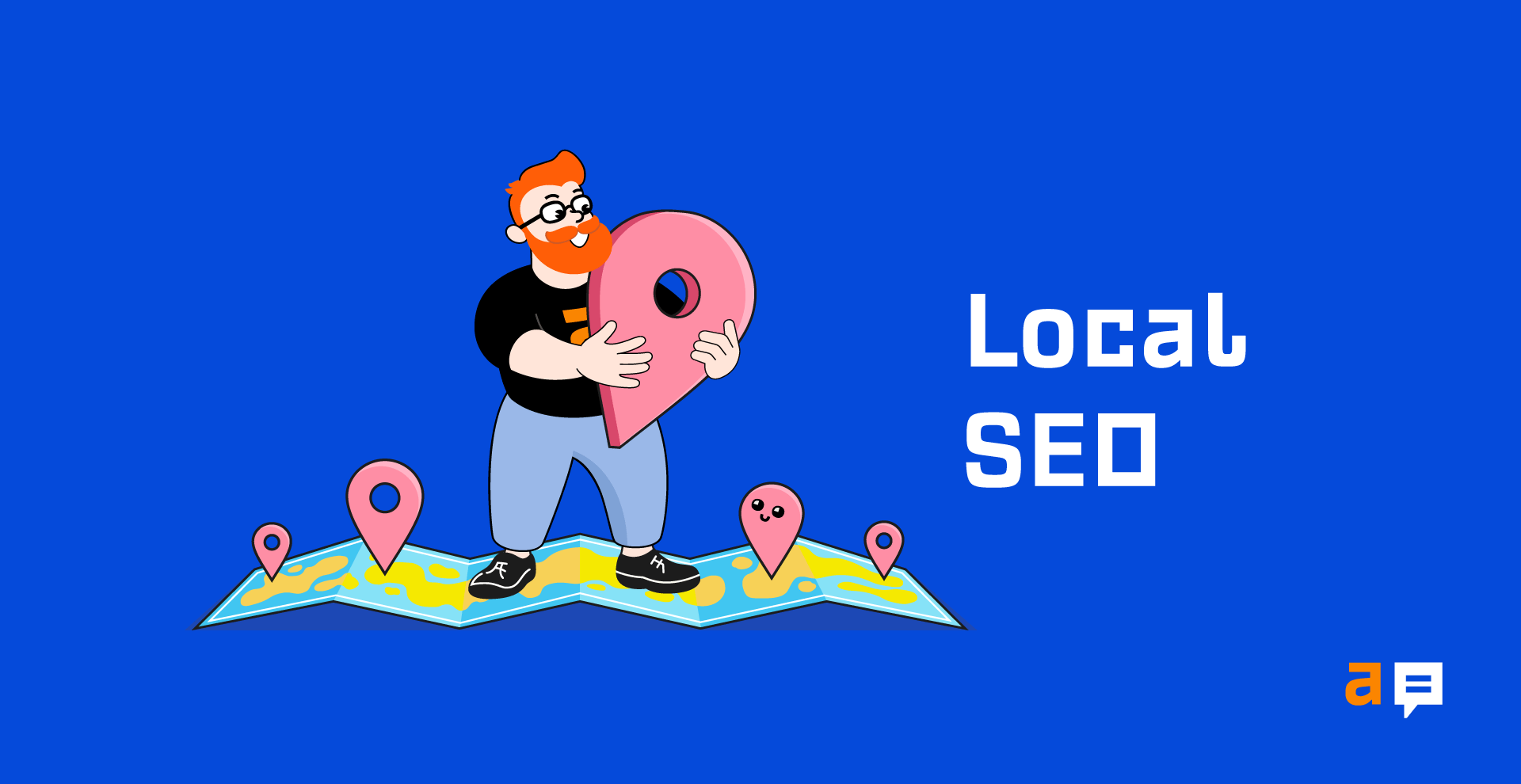SEO
Local SEO: The Complete Guide

Local SEO is the way forward if you want to get more customers to your local business from organic search.
But what is local SEO, how does it work, and which ranking factors matter?
In this guide, you’ll learn how to rank your business on local search to get more customers through your door.
First, let’s explore what local SEO is, why it matters, and how it differs from “regular” SEO.
What is local SEO?
Local SEO is the practice of improving your online presence to get more business from local searches. These searches take place on many search engines, but local SEO focuses on optimizing for Google users.
Why is local SEO important?
Local SEO is important because many people use search engines to find local businesses.
In fact, according to Google:
- 30% of all mobile searches are related to location.
- 78% of people who search for something nearby on their phones visit the business within a day.
- 28% of searches for something nearby result in a purchase.
In short, customers are searching for your business. If you’re not there, you’re leaving money on the table.
How does local SEO work?
Local SEO is a game of two halves because Google shows two types of search results for local searches. These are “map pack” results and organic “blue link” results. You can rank on both of them.

Map pack results
The map pack (aka local pack) is a Google SERP feature that shows the top local business listings and a map. It often appears at the very top of Google’s search results for local searches.
Organic search results
The “regular” organic search results are the “10 blue links” that we’re all familiar with. They usually appear below the “map pack” results.
Local keyword research is the process of understanding how people search for the local services you offer.
It’s important because you want to optimize for what people search for.
Let’s go through how to do this.
1. Find service-based keywords
Most people don’t think about the different ways that others may search for what they do.
For example, if you’re a plumber, some customers will find you by typing “plumber” into Google. But others will search for queries relating to specific services like “drain unblocking.”
For that reason, you should begin by brainstorming and listing the services you offer. This will help you maximize your presence for queries your customers are searching for.
Here’s what that can look like for a plumber:
- Drain unblocking
- Boiler repair
- Boiler installation
- Boiler servicing
- Radiator installation
- Burst pipe repair
To expand this list, use the service keywords as “seeds” to find more services people are searching for.
For example, if we plug the services above into Ahrefs’ Keywords Explorer and check the Matching terms report, we see keywords like:
- gas boiler installation
- combi boiler installation
- electric boiler installation

If you offer those services, you may also want to consider targeting these keywords.
Here’s another way to find “missed” keywords:
Plug a competing business into Ahrefs’ Site Explorer, go to the Top pages report, and look for URLs that map to services.

2. Check search volumes
Keyword research tools show you national search volumes. If you want search volumes for your state, city, or town, you’ll have to use Google Keyword Planner.

Unfortunately, Keyword Planner has its issues:
- It shows broad search volume ranges (e.g., 1K-10K), not absolute numbers.
- It groups keywords and shows a combined rounded search volume.
For that reason, checking the relative popularity of keywords at the national level tends to be more productive. This is because what happens in one city is likely to be similar in the next.
You can do this with a keyword research tool like Ahrefs’ Keywords Explorer.
For example, the tool tells us that more people search for “boiler repair” than “boiler installation” in the U.K.:

This is probably the case whichever city we’re in, so it’s an excellent way to prioritize keywords.
3. Check for local intent
Local intent means that searchers want to shop nearby. If that isn’t the case for your services, it’s not a local SEO opportunity.
To check a query for local intent, Google it and check the results.
If there’s a map pack and/or some local “blue link” results, it has local intent.

If there are no map pack and local “blue link” results, it doesn’t have local intent.

You can still target keywords without local intent, but it’s not a job for local SEO.
4. Assign keywords to pages
Your homepage is unlikely to rank for all your service keywords. So you’ll need to target some with separate pages.
To assign keywords to URLs, think about which services they map to.
If they map to very different services, such as “boiler installation” and “burst pipe repair,” assign them to separate pages.
If they map to the same service, such as “drain unblocking” and “drain unclogging,” assign them to the same page.
You can learn more about this process in our local keyword research guide below.
Learn more: How to Do Local Keyword Research
You may recall that local SEO is a game of two halves because there are two ways to rank. The first is the map pack, and the second is the “regular” organic results.
Ranking factors vary depending on where you want to rank—but some are important for both.

Below, we’ll look at what SEOs believe are the most important factors for each.
Google Business Profile (formerly Google My Business)
A Google Business Profile is a local listing with information about your business. It’s free and allows your business to appear in the map pack and Google Maps.
What SEOs say
In all, 36% of SEOs think your Google Business Profile is the most important ranking factor for the map pack. And 6% believe that it’s important for the “regular” organic results. That’s according to BrightLocal’s survey.

This isn’t surprising, as you need a Google Business Profile to stand any chance of ranking on the map pack.
Business Profile signals are increasing in their perceived importance for the map pack over time too.

Beyond rankings, Google states that customers are 70% more likely to visit businesses with a complete Business Profile. They’re also 50% more likely to consider buying from them. So it’s clear that a complete and optimized Business Profile is essential if you want to attract more business.
Best practices
Many of these best practices come from Google itself:
- Be specific when setting your business category
- Set your business hours (including holiday hours)
- Add your address (if you have a storefront)
- Set your service area (if you visit or deliver to customers and clients)
- Add the products or services you offer
- Add photos
- Ask customers for reviews
Learn more: How to Optimize Your Google My Business Listing in 30 Minutes
NAP citations
A NAP citation mentions your business’s name, address, and phone number online. They usually appear on business directories and social media profiles.
Sidenote.
There are also NAPW citations that mention your website.
What SEOs say
BrightLocal’s 2021 study shows that 7% of SEOs think citations are the most important ranking factor. That’s true for both the “map pack” and “regular” results.

In other words, they’re somewhat important—but not as important as they used to be.
The perceived importance of citations among SEOs has been declining since 2014.

That said, citations can still help searchers discover your business online. This is because directories often rank on the search results for local queries. So if you’re in those directories, the people who click on them in the search results may find your business.
Best practices
- Get listed with big data aggregators (in the U.S., these are Data Axle, Localeze, and Foursquare)
- Submit to other big players (in the U.S., these include Apple Maps, Yelp, Yellow Pages, Bing Places, and Facebook)
- Submit to other popular directories in your local area and industry
- Keep your citations consistent (same name, address, phone number) everywhere
Learn more: How to Build Local Citations (Complete Guide)
TIP
Here’s a quick way to find industry and local directories:
- Paste your homepage into Site Explorer
- Go to Link Intersect
- Enter the homepages of a few competing businesses in your area
- Set the search mode to “URL” for all targets
- Click “Show link opportunities”
This will show you sites linking to one or more of your competitors, but not you.

If a website links to many competitors, it’s probably a directory where you can also add a listing.
Reviews
Reviews refer to the quantity and quality of reviews on your Google Business Profile and elsewhere online.
What SEOs say
BrightLocal’s 2021 study shows that 17% of SEOs deem reviews the most important ranking factor for map pack rankings. But only 5% see them as most important for regular organic rankings.

Reviews have also grown in their perceived importance for map pack rankings over the past few years.

But reviews aren’t only about rankings. Getting reviews on your Google Business Profile and elsewhere builds trust with Google and customers.
Best practices
Many of these best practices for getting more reviews come from Google itself:
- Remind customers to leave reviews (you can create and share a review link in Google Business Manager)
- Focus on getting reviews on your Google Business Profile
- Respond to reviews to build trust (you’ll need a verified Google Business Profile to do this)
- Don’t offer or accept money in exchange for reviews (it’s against Google’s terms)
- Don’t discourage bad reviews or request good reviews from customers (it’s against Google’s terms)
Links
Links act like votes for your site from other websites.
What SEOs say
BrightLocal’s study shows that 31% of SEOs deem links the most important signal for ranking on regular organic search. And 13% think the same for map pack rankings.

For many, this won’t come as much of a surprise. In 2016, Google said that backlinks are one of their top three ranking factors. Plus, many studies have found a strong correlation between links and organic traffic.

Links are increasing in their perceived importance for “regular” local rankings over time too. But their perceived importance for “map pack” rankings has stayed roughly the same.

Best practices
- Get links from other top-ranking sites
- Get links your competitors have (use Ahrefs’ Link Intersect tool for this)
- Get local citations (these often have links)
- Claim unlinked mentions
- Reclaim lost links by redirecting old versions of your pages to new versions
Learn more: 9 Easy Local Link Building Tactics
On-page
On-page SEO is where you make changes to the content of a page to help it rank higher on organic search results.
What SEOs say
BrightLocal’s study shows that 34% of SEOs think on-page signals are the most important factor for regular organic search. And 16% believe it’s the most important factor for map pack rankings.

On-page signals are also growing in their perceived importance for local SEO. You can see this from the results of BrightLocal’s previous surveys.

Best practices
TIP
One way to find details that matter to searchers is to check what top-ranking pages in your area talk about. You can do this by looking at the pages. Or you can use Keywords Explorer to find keywords mentioned on the top-ranking pages.
Here’s how to do that:
- Enter [service keyword] [location] (e.g., “boiler repair london”)
- Go to the Related terms report
- Hit the toggles for “Also talk about” and “Top 10”

Here are some of the frequently mentioned keywords on the top-ranking pages for “boiler repair london” and what they likely infer:
- “gas safe” – Searchers probably want an engineer who’s on the Gas Safe Register, the official gas safety body in the U.K.
- “greater london” – Searchers probably want to know whether the business supplies this service in their area.
- “gas boiler” – Searchers probably want to know whether the business can repair their type of boiler.
- “emergency call” – Searchers probably want to know whether the business does emergency callouts.
It would be worth mentioning these things on your page.
Recommended reading: On-Page SEO: Complete Beginner’s Guide
Let’s bring things to a close with a few local SEO tools you may find useful.
Google Business Manager
Google Business Manager, formerly Google My Business, is how you manage your Google Business Profile. Signing up for it is completely free and is something every local business owner should use.
Google Search Console
Google Search Console is a free tool for monitoring your website’s search performance. It tells you how much search traffic you’re getting, where it’s going, and what keywords it’s coming from.
Ahrefs’ Rank Tracker
Rank Tracker lets you track up to 10,000 keyword rankings for “regular” organic search by country, state, city, and even ZIP/postal code.
Ahrefs Link Intersect
Our Link Intersect tool lets you find websites that link to multiple competitors. This is useful for finding relevant local and industry-specific citations.
Grid My Business
Grid My Business shows map pack ranking positions for a keyword in the area around your business. It’s freemium and is useful for understanding if and where local searchers are likely to see your business.
Yext
Yext is a tool for syncing and managing business information across multiple listings. It’s useful for keeping citations consistent, although you can do this manually.
Google Keyword Planner
Google Keyword Planner is a free keyword research tool from Google. It’s a useful source of search volume ranges at the local level.
Keep learning
Hopefully, you now have a pretty good understanding of how local SEO works. If you want to dig deeper and continue learning, check out these resources:
SEO
WordPress Insiders Discuss WordPress Stagnation

A recent webinar featuring WordPress executives from Automattic and Elementor, along with developers and Joost de Valk, discussed the stagnation in WordPress growth, exploring the causes and potential solutions.
Stagnation Was The Webinar Topic
The webinar, “Is WordPress’ Market share Declining? And What Should Product Businesses Do About it?” was a frank discussion about what can be done to increase the market share of new users that are choosing a web publishing platform.
Yet something that came up is that there are some areas that WordPress is doing exceptionally well so it’s not all doom and gloom. As will be seen later on, the fact that the WordPress core isn’t progressing in terms of specific technological adoption isn’t necessarily a sign that WordPress is falling behind, it’s actually a feature.
Yet there is a stagnation as mentioned at the 17:07 minute mark:
“…Basically you’re saying it’s not necessarily declining, but it’s not increasing and the energy is lagging. “
The response to the above statement acknowledged that while there are areas of growth like in the education and government sectors, the rest was “up for grabs.”
Joost de Valk spoke directly and unambiguously acknowledged the stagnation at the 18:09 minute mark:
“I agree with Noel. I think it’s stagnant.”
That said, Joost also saw opportunities with ecommerce, with the performance of WooCommerce. WooCommerce, by the way, outperformed WordPress as a whole with a 6.80% year over year growth rate, so there’s a good reason that Joost was optimistic of the ecommerce sector.
A general sense that WordPress was entering a stall however was not in dispute, as shown in remarks at the 31:45 minute mark:
“… the WordPress product market share is not decreasing, but it is stagnating…”
Facing Reality Is Productive
Humans have two ways to deal with a problem:
- Acknowledge the problem and seek solutions
- Pretend it’s not there and proceed as if everything is okay
WordPress is a publishing platform that’s loved around the world and has literally created countless jobs, careers, powered online commerce as well as helped establish new industries in developing applications that extend WordPress.
Many people have a stake in WordPress’ continued survival so any talk about WordPress entering a stall and descent phase like an airplane that reached the maximum altitude is frightening and some people would prefer to shout it down to make it go away.
Acknowledging facts and not brushing them aside is what this webinar achieved as a step toward identifying solutions. Everyone in the discussion has a stake in the continued growth of WordPress and their goal was to put it out there for the community to also get involved.
The live webinar featured:
- Miriam Schwab, Elementor’s Head of WP Relations
- Rich Tabor, Automattic Product Manager
- Joost de Valk, founder of Yoast SEO
- Co-hosts Matt Cromwell and Amber Hinds, both members of the WordPress developer community moderated the discussion.
WordPress Market Share Stagnation
The webinar acknowledged that WordPress market share, the percentage of websites online that use WordPress, was stagnating. Stagnation is a state at which something is neither moving forward nor backwards, it is simply stuck at an in between point. And that’s what was openly acknowledged and the main point of the discussion was understanding the reasons why and what could be done about it.
Statistics gathered by the HTTPArchive and published on Joost de Valk’s blog show that WordPress experienced a year over year growth of 1.85%, having spent the year growing and contracting its market share. For example, over the latest month over month period the market share dropped by -0.28%.
Crowing about the WordPress 1.85% growth rate as evidence that everything is fine is to ignore that a large percentage of new businesses and websites coming online are increasingly going to other platforms, with year over year growth rates of other platforms outpacing the rate of growth of WordPress.
Out of the top 10 Content Management Systems, only six experienced year over year (YoY) growth.
CMS YoY Growth
- Webflow: 25.00%
- Shopify: 15.61%
- Wix: 10.71%
- Squarespace: 9.04%
- Duda: 8.89%
- WordPress: 1.85%
Why Stagnation Is A Problem
An important point made in the webinar is that stagnation can have a negative trickle-down effect on the business ecosystem by reducing growth opportunities and customer acquisition. If fewer of the new businesses coming online are opting in for WordPress are clients that will never come looking for a theme, plugin, development or SEO service.
It was noted at the 4:18 minute mark by Joost de Valk:
“…when you’re investing and when you’re building a product in the WordPress space, the market share or whether WordPress is growing or not has a deep impact on how easy it is to well to get people to, to buy the software that you want to sell them.”
Perception Of Innovation
One of the potential reasons for the struggle to achieve significant growth is the perception of a lack of innovation, pointed out at the 16:51 minute mark that there’s still no integration with popular technologies like Next JS, an open-source web development platform that is optimized for fast rollout of scalable and search-friendly websites.
It was observed at the 16:51 minute mark:
“…and still today we have no integration with next JS or anything like that…”
Someone else agreed but also expressed at the 41:52 minute mark, that the lack of innovation in the WordPress core can also be seen as a deliberate effort to make WordPress extensible so that if users find a gap a developer can step in and make a plugin to make WordPress be whatever users and developers want it to be.
“It’s not trying to be everything for everyone because it’s extensible. So if WordPress has a… let’s say a weakness for a particular segment or could be doing better in some way. Then you can come along and develop a plug in for it and that is one of the beautiful things about WordPress.”
Is Improved Marketing A Solution
One of the things that was identified as an area of improvement is marketing. They didn’t say it would solve all problems. It was simply noted that competitors are actively advertising and promoting but WordPress is by comparison not really proactively there. I think to extend that idea, which wasn’t expressed in the webinar, is to consider that if WordPress isn’t out there putting out a positive marketing message then the only thing consumers might be exposed to is the daily news of another vulnerability.
Someone commented in the 16:21 minute mark:
“I’m missing the excitement of WordPress and I’m not feeling that in the market. …I think a lot of that is around the product marketing and how we repackage WordPress for certain verticals because this one-size-fits-all means that in every single vertical we’re being displaced by campaigns that have paid or, you know, have received a a certain amount of funding and can go after us, right?”
This idea of marketing being a shortcoming of WordPress was raised earlier in the webinar at the 18:27 minute mark where it was acknowledged that growth was in some respects driven by the WordPress ecosystem with associated products like Elementor driving the growth in adoption of WordPress by new businesses.
They said:
“…the only logical conclusion is that the fact that marketing of WordPress itself is has actually always been a pain point, is now starting to actually hurt us.”
Future Of WordPress
This webinar is important because it features the voices of people who are actively involved at every level of WordPress, from development, marketing, accessibility, WordPress security, to plugin development. These are insiders with a deep interest in the continued evolution of WordPress as a viable platform for getting online.
The fact that they’re talking about the stagnation of WordPress should be of concern to everybody and that they are talking about solutions shows that the WordPress community is not in denial but is directly confronting situations, which is how a thriving ecosystem should be responding.
Watch the webinar:
Is WordPress’ Market share Declining? And What Should Product Businesses Do About it?
Featured Image by Shutterstock/Krakenimages.com
SEO
Google’s New Support For AVIF Images May Boost SEO

Google announced that images in the AVIF file format will now be eligible to be shown in Google Search and Google Images, including all platforms that surface Google Search data. AVIF will dramatically lower image sizes and improve Core Web Vitals scores, particularly Largest Contentful Paint.
How AVIF Can Improve SEO
Getting pages crawled and indexed are the first step of effective SEO. Anything that lowers file size and speeds up web page rendering will help search crawlers get to the content faster and improve the amount of pages crawled.
Google’s crawl budget documentation recommends increasing the speeds of page loading and rendering as a way to avoid receiving “Hostload exceeded” warnings.
It also says that faster loading times enables Googlebot to crawl more pages:
Improve your site’s crawl efficiency
Increase your page loading speed
Google’s crawling is limited by bandwidth, time, and availability of Googlebot instances. If your server responds to requests quicker, we might be able to crawl more pages on your site.
What Is AVIF?
AVIF (AVI Image File Format) is a next generation open source image file format that combines the best of JPEG, PNG, and GIF image file formats but in a more compressed format for smaller image files (by 50% for JPEG format).
AVIF supports transparency like PNG and photographic images like JPEG does but does but with a higher level of dynamic range, deeper blacks, and better compression (meaning smaller file sizes). AVIF even supports animation like GIF does.
AVIF Versus WebP
AVIF is generally a better file format than WebP in terms of smaller files size (compression) and image quality. WebP is better for lossless images, where maintaining high quality regardless of file size is more important. But for everyday web usage, AVIF is the better choice.
See also: 12 Important Image SEO Tips You Need To Know
Is AVIF Supported?
AVIF is currently supported by Chrome, Edge, Firefox, Opera, and Safari browsers. Not all content management systems support AVIF. However, both WordPress and Joomla support AVIF. In terms of CDN, Cloudflare also already supports AVIF.
I couldn’t at this time ascertain whether Bing supports AVIF files and will update this article once I find out.
Current website usage of AVIF stands at 0.2% but now that it’s available to surfaced in Google Search, expect that percentage to grow. AVIF images will probably become a standard image format because of its high compression will help sites perform far better than they currently do with JPEG and PNG formats.
Research conducted in July 2024 by Joost de Valk (founder of Yoast, ) discovered that social media platforms don’t all support AVIF files. He found that LinkedIn, Mastodon, Slack, and Twitter/X do not currently support AVIF but that Facebook, Pinterest, Threads and WhatsApp do support it.
AVIF Images Are Automatically Indexable By Google
According to Google’s announcement there is nothing special that needs to be done to make AVIF image files indexable.
“Over the recent years, AVIF has become one of the most commonly used image formats on the web. We’re happy to announce that AVIF is now a supported file type in Google Search, for Google Images as well as any place that uses images in Google Search. You don’t need to do anything special to have your AVIF files indexed by Google.”
Read Google’s announcement:
Supporting AVIF in Google Search
Featured Image by Shutterstock/Cast Of Thousands
SEO
CMOs Called Out For Reliance On AI Content For SEO

Eli Schwartz, Author of Product-Led SEO, started a discussion on LinkedIn about there being too many CMOs (Chief Marketing Officers) who believe that AI written content is an SEO strategy. He predicted that there will be reckoning on the way after their strategies end in failure.
This is what Eli had to say:
“Too many CMOs think that AI-written content is an SEO strategy that will replace actual SEO.
This mistake is going to lead to an explosion in demand for SEO strategists to help them fix their traffic when they find out they might have been wrong.”
Everyone in the discussion, which received 54 comments, strongly agreed with Eli, except for one guy.
What Is Google’s Policy On AI Generated Content?
Google’s policy hasn’t changed although they did update their guidance and spam policies on March 5, 2024 at the same time as the rollout of the March 2024 Core Algorithm Update. Many publishers who used AI to create content subsequently reported losing rankings.
Yet it’s not said that using AI is enough to merit poor rankings, it’s content that is created for ranking purposes.
Google wrote these guidelines specifically for autogenerated content, including AI generated content (Wayback machine copy dated March 6, 2024)
“Our long-standing spam policy has been that use of automation, including generative AI, is spam if the primary purpose is manipulating ranking in Search results. The updated policy is in the same spirit of our previous policy and based on the same principle. It’s been expanded to account for more sophisticated scaled content creation methods where it isn’t always clear whether low quality content was created purely through automation.
Our new policy is meant to help people focus more clearly on the idea that producing content at scale is abusive if done for the purpose of manipulating search rankings and that this applies whether automation or humans are involved.”
Many in Eli’s discussion were in agreement that reliance on AI by some organizations may come to haunt them, except for that one guy in the discussion
Read the discussion on LinkedIn:
Too many CMOs think that AI-written content is an SEO strategy that will replace actual SEO
Featured Image by Shutterstock/Cast Of Thousands
-

 SEO7 days ago
SEO7 days agoGoogle’s Revamped Documentation Shows 4 Reasons To Refresh Content
-
SEARCHENGINES5 days ago
Daily Search Forum Recap: August 26, 2024
-

 SEARCHENGINES7 days ago
SEARCHENGINES7 days agoGoogle Ranking Bug Fixed, August Core Update Swings, AI Overviews, Google Ads Bug & More
-
SEARCHENGINES4 days ago
Daily Search Forum Recap: August 27, 2024
-

 WORDPRESS7 days ago
WORDPRESS7 days agoHow to Secure Your WordPress Store
-

 AFFILIATE MARKETING7 days ago
AFFILIATE MARKETING7 days agoBusiness Owners are Batting 1,000 With This All-in-One Management Hub
-

 SEARCHENGINES6 days ago
SEARCHENGINES6 days agoGoogle Migrating All To Google Merchant Center Next By September
-

 WORDPRESS5 days ago
WORDPRESS5 days ago10 Best StudioPress Alternatives (Genesis Framework)















You must be logged in to post a comment Login